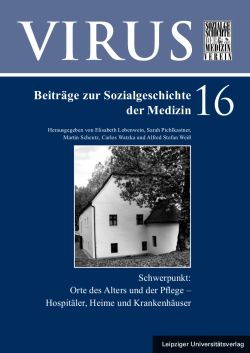
VIRUS Band 16, pp. 127-139, 2020/07/22
Schwerpunkt: Orte des Alters und der Pflege – Hospitäler, Heime und Krankenhäuser

This article highlights ‘enclosed’ facilities caring for the poor and the sick in Leipzig – the St. Georg and the St. Johannis Hospitals as well as the Plague Lazaretto. It traces long-standing traditions reaching from the Early Modern Period to the 19th century. In this context, it outlines development processes that led to a differentiated medical and nursing care landscape. The Johannis Hospital, for example, became an elderly care facility. The Lazaretto, which was originally built to receive people infected with the plague, sowed the seeds for a modern hospital. At the same time, these micro-historical investigations demonstrate that the processes of differentiation and profile shaping going on within the care landscape of Leipzig involved the exclusion of previous facility occupant groups.
Keywords: Saxony, Leipzig, medical history, history of hospitals, history of patients, Early Modern Period, 19th century, microhistory, historical anthropology